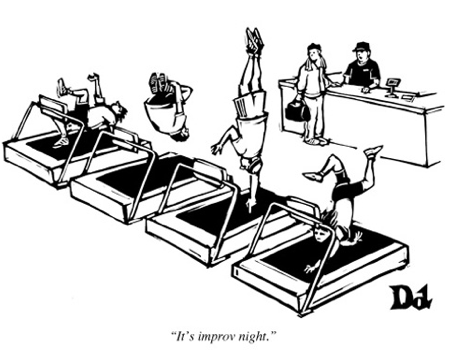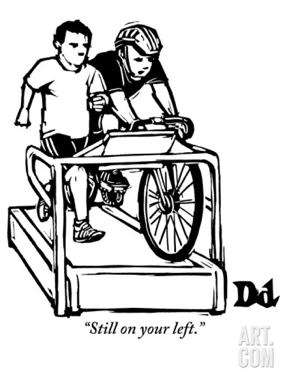Gyms have replaced bars as America’s favorite gathering places. But depending on time of day and year, health clubs are typically agog with lycra-spun exhibitionism, squadrons of Spinners and Cross-fitters, or quieter than a Trappist monastery. Now gyms are moving outside with boot camps and paleo-style workouts leading the fitness charge.
The TV, radio and print ads for health club memberships start assaulting our senses within hours of the New Year’s Ball dropping in Times Square. Then there’s the insidious “New Year, New You” mantra annually drummed into our post-holiday noggin’. Weight-loss and fitness goals suddenly become addressed with newfound gusto and personal commitment. For runners, who are already in shape and hate the cold, treadmills are their salvation, that is, if the motivation-sapping boredom doesn’t intervene first.
Many gyms depend on January as their membership dues-paying cash cow. It’s a winning formula that gyms can bank on. Based on years of past experience, health clubs know that most new members will soon regularly stop coming in, so they try to lock in as many early memberships as possible.
To keep that revenue pipeline healthy, clubs typically offer three membership options: 1.) initiation fee, monthly contract, and a monthly fee that’s automatically debited from your credit card or bank account; 2.) initiation fee and annual contract paid in full or spread out over time; and 3.) pay-per-visit, often in the form of a multi-visit pass.
But here’s the financial kicker: even if you’ve stopped going to the gym though you signed up month-to-month or annually, your membership dues will most likely continue to appear on your monthly credit card or bank statement. Trying to get this cleared will make you sweat.
Lesson number one if you want to join a gym: ask questions and read the fine print of any health club membership agreement so you fully understand the contractual obligations. Even that “free” monthly or weekly trial can be misleading if you are required to hand over your credit card or bank information. You might still get billed when the trial period is over. Canceling can turn into a time-consuming headache.
 Many clubs heavily rely on high-pressure sales tactics. In exchange for what appears like a great deal, that fit-looking sales consultant hovering by the front desk will often pressure you to sign up right then and there. By all means, don’t! Take the contract home. Scrutinize it carefully. Try checking out the local competition. See what classes they offer. Visiting a new club for the first time is not unlike stepping onto an used-car lot. Try to avoid feeling intimidated if you are a newbie. Feel free to negotiate membership terms; you might be able to receive tremendous savings.
Many clubs heavily rely on high-pressure sales tactics. In exchange for what appears like a great deal, that fit-looking sales consultant hovering by the front desk will often pressure you to sign up right then and there. By all means, don’t! Take the contract home. Scrutinize it carefully. Try checking out the local competition. See what classes they offer. Visiting a new club for the first time is not unlike stepping onto an used-car lot. Try to avoid feeling intimidated if you are a newbie. Feel free to negotiate membership terms; you might be able to receive tremendous savings.
Yet the best health-club membership option for many is pay-per-visit. That’s the conclusion drawn from a three-year study of fitness clubs conducted by University of California at Berkeley’s economics professor Stefano Della Vigna. After carefully reviewing the records of nearly 8,000 gym memberships in the Boston area, the academic data cruncher discovered that “gym users on monthly plans pay 70 percent more than those pay-as-you-go plans based on usage.”
Vigna published his findings in The American Economic Review, which is hardly the kind of sweat-stained periodical you find stashed in the reading bin by the stationary bikes and ellipitical machines. Since consumer behavior is not always based on rational decision-making, new gym members often fail to take into account declining interest in working out. “Gym members who choose a contract with a flat monthly fee of over $70 attend on average 4.3 times per month,” explained Vigna. “They pay a price per expected visit of more than $17, even though they could pay $10 per visit using a 10-visit pass. On average, these users forgo savings of $600 during their membership.”
The study produced another interesting set of results reflecting consumer habits. “Members who choose a monthly contract are 17 percent more likely to stay enrolled beyond one year than users committing for a year. This is surprising because monthly members pay higher fees for the option to cancel each month.”
Seeking to explain this statistical anomaly, Vigna theorized that “overconfidence about future self-control” is the reason. In other words, those signing up for an annual membership might have set unrealistic fitness goals for themselves, and when they fail to reach these benchmarks, they become less motivated and more likely to quit than month-to-month users.
Vigna found that monthly users are reluctant to quit their membership even if they stop working out. On average, just over two entire months elapse between the last club visit and contract termination for monthly members. Which means a monthly user can be expected to lose two hundred dollars or more before finally deciding to throwing in the membership towel.
Meanwhile, the health club industry is going strong. About 17,000 clubs are now operating in the U.S., with memberships topping 32 million, nearly double the number from 20 years ago. But that mega-membership number is misleading. Mark Lipanski, a personal trainer in Menlo Park, California, told the San Francisco Chronicle that “about 12 percent to 15 percent of Americans own gym memberships, and of those, 40 percent actually use them. Within that group, less than half work out regularly and vigorously.”
 Okay, but all this discussion begs the larger question: are gyms, in fact, the best place to get back or stay in shape? The New York Times Health blog once addressed this very topic. Here’s a brief sampling of readers’ comment taken from the lively online forum. Surprisingly, the ayes were greatly outnumbered by the nays. Perhaps anti-gym advocates are simply more vocal.
Okay, but all this discussion begs the larger question: are gyms, in fact, the best place to get back or stay in shape? The New York Times Health blog once addressed this very topic. Here’s a brief sampling of readers’ comment taken from the lively online forum. Surprisingly, the ayes were greatly outnumbered by the nays. Perhaps anti-gym advocates are simply more vocal.
–“I have two awesome trainers. They are canine, and, doggone, they are very motivational. Our gym is the neighborhood.”
–“I’m one of those people who have joined gyms, gone a few times, and then dropped out. Even a discounted membership is not a good deal if you don’t use it.”
–“Best deal on the best gym in New York. No scams. Open all hours. Myriad places to work out. Clear air.. Fascinating clientele. Pets welcome! Year-round program. And here’s the amazing part: It’s free. We know it as Central Park.”
–“If you are just getting back into working out regularly, try to get a short term membership like 3-months, a punch card or make sure that you can cancel a membership when you want. I’ve walked away from gyms without those conditions”.
— “During the first few months you can understand a lot more about the gym than you can during the free 1-2 week trial period. Do you like the instructors? Are they helpful to newcomers? Do you feel comfortable in the classes or in the weights and cardio area? If you don’t feel at home in a gym it will be harder to go.”
.
–“If you are making a New Year’s resolution and you have never set foot in a gym, invest some money into paying for a trainer who can show you what to do and who can make sure that you don’t look stupid or ignorant about what to do in the gym and how to do it the right way (without hurting yourself). Showing up in a gym without a clue about what to do next and how to do it is a pretty effective way to get yourself demotivated from ever showing up in a gym again.”
— “Invest your money in equipment for your home, if you don’t have space, run outside or do video tapes. You waste a tremendous amount of time packing a bag, then getting to the gym, and then back home. Plus it’s really expensive. You can get into great shape exercising 45 minutes a day at home.”
–“At varying times over the last 20 years I’ve had a membership.7 different gyms in 3 different states. Every time I cancelled my contract within the agreements they would still continue to send me bills/direct deposit. Buy a book, a bench and a couple of dumbbells because today’s “membership sale” will just be a cancellation nightmare in the future.”
–“Music killed the gym for me.”
–“A motivated individual can avoid the gym scam and keep healthy at home without needing weights and equipment. and save some cash for proper nutrition. A beginner workout can include 10 calf raises. 10 squats, 10 lunges, 10 situps, 10 pushups. Each workout level increase by 10 each. All must be done within an hour; you can pick your own rest/rep/sets. When you can do 50x of each within an hour you can label yourself as fit. 100x and well, you’ll look good naked.”
As for me, I am perfectly content working out at home and using the outdoors for my running and biking. I pretty much loathe the treadmill and stationary bike. Twenty minutes on either is my absolute threshold. The monotony is too much. Nor have I ever worn a Walkman or iPod earbuds in over 30 years of running. I prefer to listen to my own thoughts. Or rather, running and biking clear my head. Going to a gym, on the other hand, certainly never accomplished that in the past. And as for weight training, I do pushups, chinups, and pullups at home. When i started my pushup regimen several years ago, I could only do 35; with chinups, it was 2. Yesterday morning, I cranked out 250 pushups to muscle exhaustion– all without stopping. Then, several hours after a small lunch of rice and salmon, I ran for 75 minutes on the nearby trails that involved a steady two-mile climb. I saw about a dozen mountain bikers, several hikers, but no other runners. It was New Year’s Day.
***
This essay was adapted in part from Bill Katovsky’s memoir, “Return to Fitness: Getting Back in Shape After Injury, Illness or Prolonged Inactivity”

